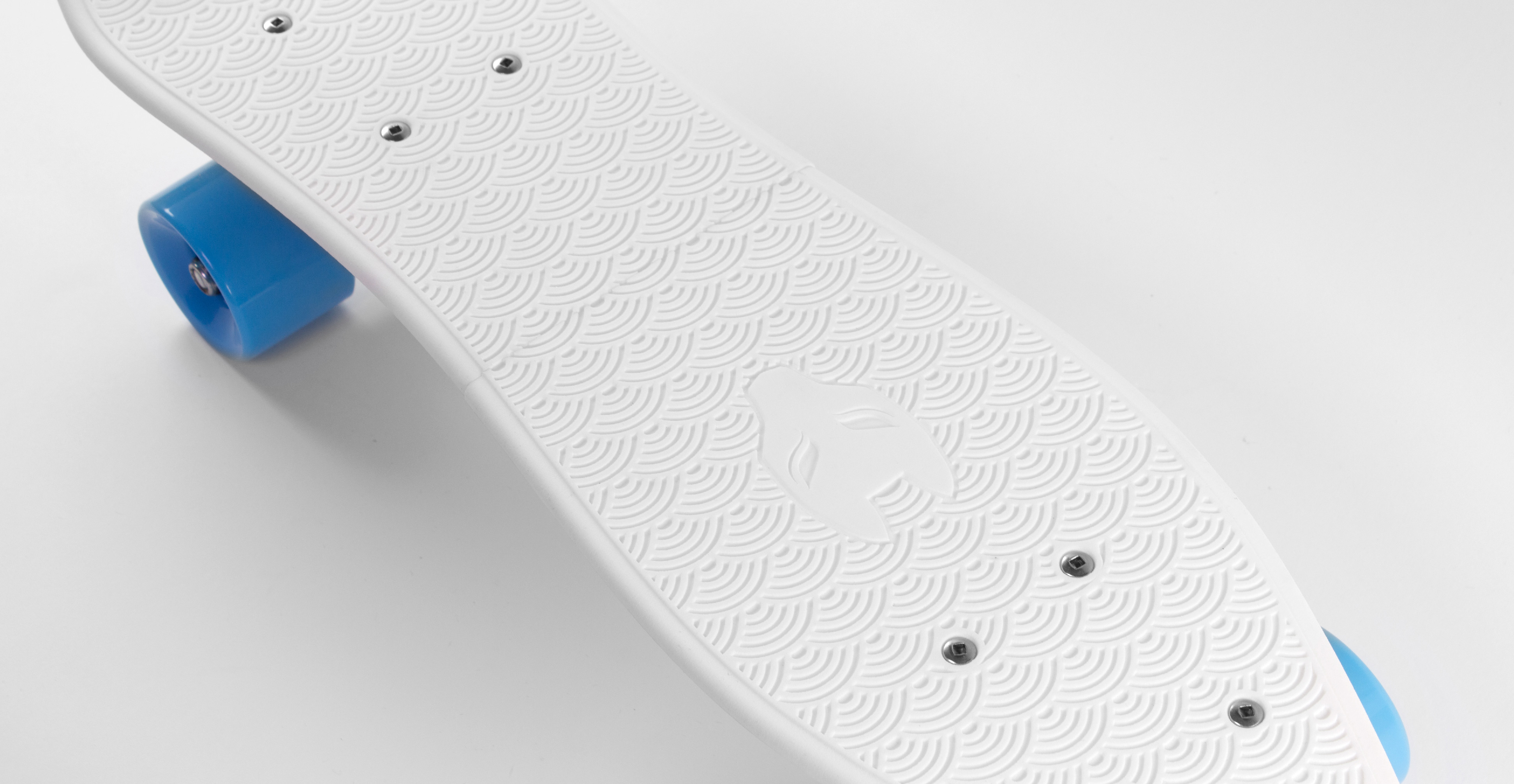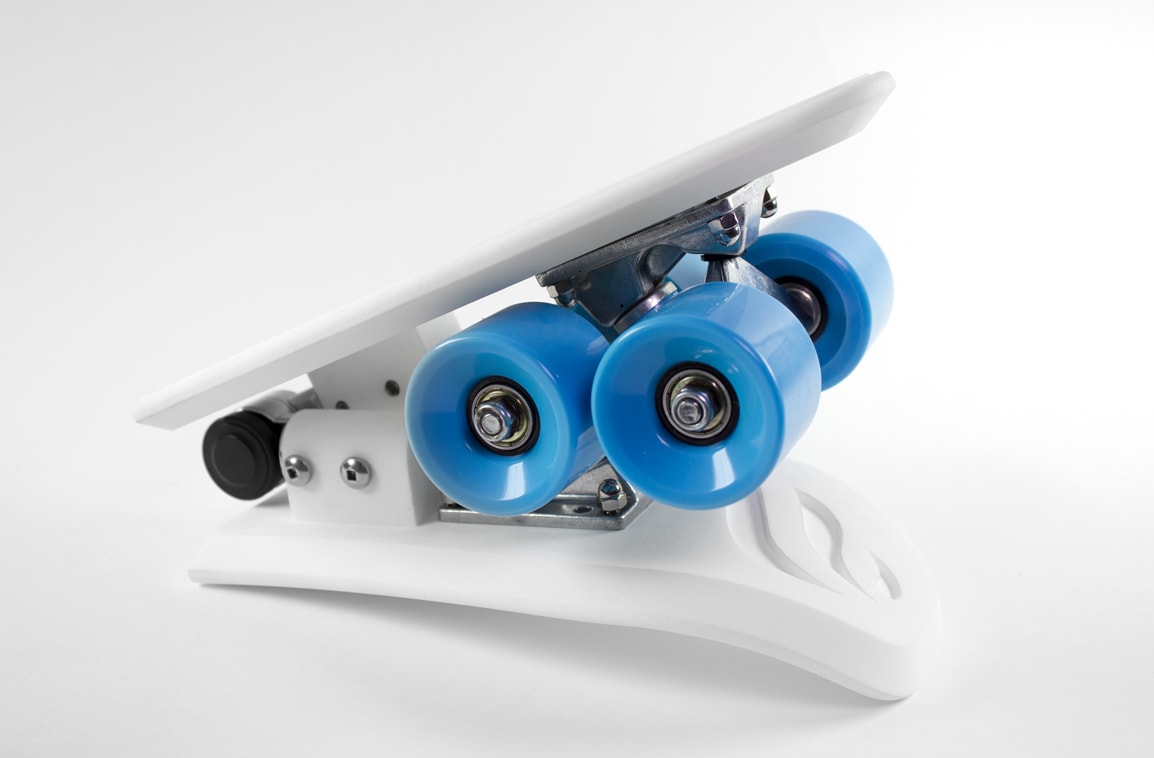Kitsune Board
challenge —
To find an effective, alternative solution to the urban commute through an engaging, user-connected product.


The Kitsune Board is intended to bring forth a change in the way we see commuting. Going from point A to point B needs to become a positive, health conscious experience. I investigated how we can create a vehicle representing both social and environmental change, while at the same time allow everyone to enjoy an easier, more environmentally conscious commute.

initial research —
By looking beyond similar, more traditional products (skateboards and Penny boards), I created a board that is compact enough for everyday use but with the goal of building a change. Two key features help this product reach this goal; the board itself has a locking and folding feature providing ease of transport and storage, as well as a companion app to create a system of engaged, connected users.
The Kitsune Board is directed at a wide demographic, who are open to new products, and seeking alternative modes of transportation. Many living in urban centres rely heavily on the public transit system. While their current system works, I wanted to present them with improvements. Few have luxury of living near a public transit platform; they lose valuable time commuting to and from transit options.
While foldability allows for a more portable solution, it’s also meant to build a strong user/product bond.
research conclusion —
When looking towards the future, I wanted to explore new possibilities in human commuting behaviour that are rarely reviewed. By identifying pain points, I sought to improve upon congested areas of a user’s commute. These primarily being between transit systems where the user finds themselves walking for five to ten minutes to meet their transfer. Finding solutions to these pain points allowed me to solve the problems as a whole.
Johnathan Ive
There is beauty when something works and it works intuitively.
competitor research —
I started by looking for reference material to help me gauge the general size and dimensions of the board. I looked for weak points in the design of similar boards and ways to improve them.
One of the leaders in the plastic skateboard market is Penny. Their boards are popular because of their relatively retro style and size. By looking to their design as inspiration, I could find ways to improve my own board while focusing on human centred design approach.
One of the biggest challenges that I found with these styles of boards is the foot placement. In order to stick to an effective size, Penny made the board thin and sleek. However, with this comes discomfort when riding. Because everyone has varying foot sizes, I found this issue was a good starting point to focus on when approaching my design.
I designed the general shape of the board to be 22’’ long and 6’’ wide at the apex. You’ll notice that near the front and back of the board there are two wider sections; this allows for the board to be better accommodating to individual foot placement.
The bottom grip pattern represents the nine tails of the Kitsune Fox.
user personas / job stories —
In order to allow for a true understanding of the audience this product would be directed towards I created user personas to help identify the target audience.
Jamey 20, Student
Jamey is an environmentally conscious student who regularly uses public transit. He is very conscious of his carbon footprint. As he is quite interested in technology, he is comfortable exploring and trying new products. However, being a student, Jamey doesn’t have a very large disposable income.
Nancy 28, Personal Trainer
Nancy is active both during work hours and off hours. She often uses multiple apps to help during her training and workout routines. She is constantly looking for new ways to stay active. She is interested in retaining as much data about her training as possible.
Thomas 23, Commuter
Thomas is a young professional working in the city. He lives a short distance from his transit to work and is looking for a way to help reduce travel time. He often roller blades from his condo to his train during his commute.
This solution however is bulky and inconvenient.


product research —
To find a cohesive solution to the problems presented in the user personas I put together a couple of key touch points I wanted to address when creating the product.
Portability
In Thomas’ daily commute, to reduce time, uses roller blades rather walking. Once there, however, he must remove, and carry bulky rollerblade with him on this way to the office.
With the Kitsune Board I wanted to create a solution that was convenient and compact. In order to do so, I looked at designing the board in such a way that would allow for storage and portability. I also wanted to look for a way that the board could be easily carried if the user didn’t have storage available.
Connectivity
Nancy, like many users today, gain more out the product when it is paired with a mobile component. From the beginning, I knew I was not only going to be designing a physical product but an experience that would link both the user and the product together.
To do this I looked toward NFC Technology and a mobile component that would allow a user to feel more engaged with the technology, rather than becoming passive.
brand creation—
The name Kitsune comes from the Japanese word for fox. Common figures in Japanese folklore, the kitsune are often depicted as tricksters, but also represent wisdom and transformation.
A common trait related to the Kitsune is shapeshifting—a trait that I wanted to be prevalent when designing the skateboard. As skateboarding is sometimes seen as a unique and youthful mode of transportation, I wanted to find a brand figure that relates to those tropes, while also bringing in new traits to the product.
creation / prototyping —
To take my drawings and illustrator wires to a physical product, I used the 3D fabrication program Rhino. By building the centeral elements in Illustrator, I was able to import and work seamlessly between the two programs.
After 5 prototype versions, I handed off the model to Shapeways, a 3D printing company in New York. They used a powered plastic 3D printing process to produce the board. This method provided a stronger final product than that offered using the standard consumer injection mold process. After receiving the two 3D printed pieces, I attached the hinge and wheel hardware, completing the board.